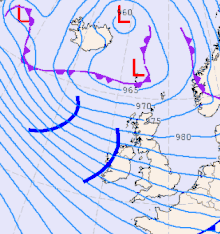2017–18 European windstorm season
| First storm formed | 12 September 2017 |
|---|---|
| Last storm dissipated | 14 June 2018 |
| Strongest storm1 | Storm Fionn (935 hPa) |
| Strongest wind gust | 274 kilometres per hour (170 mph) (Storm Cora) |
| Total storms | 18 |
| Total damage | £2.419 billion + |
| Total fatalities |
123 in total (70 direct and 53 indirect) (without the fatalities of the cold wave) |
|
1Strongest storm is determined by lowest pressure and maximum recorded non-mountainous wind gust is also included for reference. ← 2016–17 2018–19 → | |
The 2017–18 European windstorm season, or the 2017–18 UK and Ireland windstorm season was the third instance of the United Kingdom's Met Office and Ireland's Met Éireann naming of high impact extratropical cyclones and the first instance of Spanish, Portuguese and French naming as well. This season was also the deadliest windstorm season for the UK and Ireland since official naming began in 2015. In addition, a major amount of the season's damage was due to two of its storms – Emma and Ophelia and the "Beast from the East" cold wave. The first system, Storm Aileen, formed on 12 September. The season also featured Hurricane Ophelia, which impacted the Azores, Portugal and Spain, before it transitioned into an extratropical cyclone and impacted the United Kingdom and Ireland. Storm Brian struck Ireland less than a week later, resulting in three further fatalities.
Background and naming
In 2015, the Met Office and Met Éireann announced a pilot project to name storm warnings as part of the Name our Storms project for wind storms and asked the public for suggestions. The meteorological offices produced a full list of names for 2015–16 and 2016–17, common to both the UK and Ireland. A new list of names was released on 6 September 2017 for the 2017–18 season.[1] Names in the UK will be based on the National Severe Weather Warning Service, when a storm is assessed to have the potential for an Amber 'be prepared' or Red 'take action (danger to life)' warning.
The following were selected as storm names:[2]
|
|
|
The Met Office's and Met Éireann's announcement of the season's names also noted that Fionn is to be pronounced 'Fyunn', Niall is to be pronounced 'Nye-ul' and Tali is to be pronounced 'Tarly'. In addition to the names on the list, when Ophelia, named Ophelia by the NHC, transitioned from tropical to extratropical and was expected to hit Ireland and the UK as a hurricane-strength windstorm, the Met Office and Met Éireann allowed it to retain its NHC-designated name instead of naming it Brian. (Only Aileen had previously occurred in the season.)
A storm will be named when it is deemed able to have a "substantial" impact on the UK or Ireland. They will be taken from the list, in alphabetical order, alternating between male and female names – the same naming convention that is used by the United States for tropical cyclones. In the case of storms resulting from ex-tropical storms and hurricanes, the original name allocated by the US National Hurricane Center will be used, an example of which during this season is Ophelia. Met Éireann name any storm which triggers a status Orange or Red weather warning for wind. The basis for such, as outlined on their weather warning service, are mean wind speeds in excess of 40 mph (65 km/h) or gusts over 68 mph (110 km/h). Similarly, the Met Office name storms that have the potential to cause medium (Amber) or high (Red) impacts to the UK. It describes the wind strength relative to observations such as "falling trees or tiles, other items like garden furniture being blown around and even a number of properties left without electrical power."
On 1 December 2017, the national meteorological services of Spain (Aemet), France (Météo-France) and Portugal (IPMA) announced that they would begin naming storms affecting their nations in co-ordination, under the auspices of EUMETNET.[3][4]
It is intended that the naming system will be reciprocal with that of the UK and Ireland.[5] It has been reported that for the 2018–2019 season these nations and the UK and Ireland will combine their storm naming lists into one.[6]
|
|
|
Another important and internationally recognised naming system for European windstorms is the Adopt a Vortex program of the Free University of Berlin.[7] Participants can ask the FUB to give their names, for example as a birthday present, to high or low pressure systems that affect European weather. The naming service of the FUB is commercial and is the main meteorological naming system in Germany. The names Xavier, Herwart and Hartmut (the anticyclonic cold wave) were given by the FUB. Its naming program is still recognised in some other European countries, although the British-Irish and the French-Spanish-Portuguese naming co-operations are gaining more and more importance. Furthermore, besides of the 3 internationally recognised naming systems (the two European co-operations and the FUB system), many European countries (Norway, Finland, Denmark etc.) give their own names to cyclones. One of the 16 storms of the season (Cora/Aku) has not been named by the 3 main naming systems, instead it was called Cora in Norway and Aku in Finland.
Season summary

The 2017–18 UK and Ireland windstorm season began on September with storm Aileen, which brought strong winds to Scotland and Northern England on 13 September. Aileen then moved out to North Sea only then to be renamed Sebastian. Then followed Ophelia which was once a Category 3 major hurricane and the eastern-most major hurricane on record. Due to Ophelia's arrival, a red, severe wind warning was issued for many parts in Ireland. Less than a week later, storm Brian rapidly intensified from a trough of low pressure out in the Atlantic. After a rather quiet November without any named systems like quiet Septembers and Octobers of the last 2 years, Caroline and Dylan formed in December followed by Eleanor early in January 2018. In the middle of January, the extremely deep and large arctic low Fionn affected both the UK and Ireland and steered David, a smaller but more intense storm on a westerly track over Ireland, the UK and Central Europe. The last storm in January was Georgina, a cyclone that mainly affected Ireland and Scotland.
A total of 10 storms affected both UK and Ireland in that season. Out of the 10 storms, 3 storms (Ophelia, David and Emma) were named by foreign agencies. Furthermore, a high pressure area (Hartmut) triggered a cold wave, intense snowfall and some hurricane-force gusts. Though, that system has not been counted as a storm in this article since it was an anticyclone, in contrast to all the other systems that were of cyclonic nature.
Furthermore, 6 storms were named by the new co-operation of the meteorological services of France, Spain and Portugal. 2 of these storms (David and Emma) also affected Britain and Ireland significantly. The impact of the deadly winter storm Emma was intensified by the collision with the Beast from the East cold wave (Hartmut). Cora, another significant windstorm, affected Scandinavia, Norway and Sweden in particular. Cora delivered the highest known gust of the European windstorm season so far. As a European total, 18 windstorms (1 "off-season") affected the continent as of 18 July 2018.
Storms
Storm Aileen
| Aileen | |
|---|---|
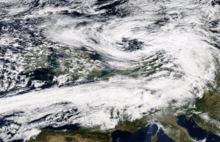 Aileen located over the North Sea on 13 September 2017 | |
| Area affected | Northwestern Europe |
| Date of impact | 12–13 September |
| Maximum wind gust | 100 mph (161 km/h) Borkum Island, Germany[8] |
| Lowest pressure | 978 hPa (28.9 inHg)[9] |
| Fatalities | 3[10] |
| Power outages | 69,000 |
| Damage | Unknown |
Aileen formed on 12 September, with the Met Office issuing an Amber wind warning, becoming the first named storm of the season. Aileen affected Cheshire, Lancashire, Derbyshire, Yorkshire, Nottinghamshire and Lincolnshire during the evening of 12 September and into the morning of 13 September with winds of over 65 km/h (55 mph). Gusts up to around 110 km/h[11] (75 mph) were also seen in exposed locations such as along coastlines and over high ground in these areas.[12] A Yellow weather warning for rain was also issued for parts of Northern Ireland, northern England and southern Scotland, as Aileen dropped 30–40 mm of rain within 6–9 hours in these areas, causing some disruption from localised flooding.[12] The heaviest rainfall was recorded at Bainbridge, North Yorkshire, with 35.4 mm falling overnight.[13]
During Aileen, approximately 60,000 homes in Wales and almost 9,000 across England suffered power cuts.[13][14] The strongest gusts, of 83 mph, were recorded at The Needles, Isle of Wight.[13] The strongest gust on mainland Britain, of 74 mph, was recorded at Mumbles, Wales.[13]
Aileen later crossed the North Sea and intensified, going on to affect Germany, where it was known as Cyclone Sebastian.[15]
Cyclone Xavier
| Xavier | |
|---|---|
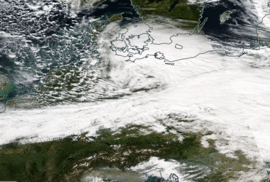 Aqua Modis satellite view of Xavier crossing Germany and Poland on 5 October 2017. | |
| Area affected | Germany, Poland, Czech Republic |
| Date of impact | 4–6 October |
| Maximum wind gust | 126 mph (202 km/h), (Mountain value) Sněžka, Czech Republic[16] |
| Lowest pressure | 985 hPa (29.1 inHg)[17] |
| Fatalities | 9[18] |
| Power outages | Unknown |
| Damage | Unknown |
Cyclone Xavier was a European windstorm which crossed northern Europe in early October 2017. Germany was the worst affected country, with high winds between 4 and 6 October causing severe damage, including in and around Berlin. Further damage was reported in the Czech Republic, where the highest winds of up to 125 miles per hour (201 km/h) were recorded, and in Poland.
Ex-Hurricane Ophelia
| Ophelia | |
|---|---|
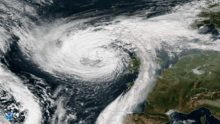 Ex-Hurricane Ophelia moving over Ireland on 16 October | |
| Area affected | Portugal, Spain, France, Ireland, United Kingdom, Faroe Islands, Norway |
| Date of impact | 16–17 October[19] |
| Maximum wind gust | 84 kn (97 mph; 156 km/h)[20] |
| Lowest pressure |
959 hPa (28.3 inHg)[21] or 962.2 hPa (28.41 inHg)[22] (onshore) 958 hPa (28.3 inHg) [23] (offshore) 960 hPa (28 inHg) (offshore, while tropical) |
| Fatalities | 3 direct, 51 indirect |
| Power outages | 360,000 |
| Damage | € 60 million[24] |
On 12 October, the Met Office issued yellow weather warnings relating to the extra-tropical remnants of the former Hurricane Ophelia, estimated to affect the UK and Ireland on 16 October.[25] Met Éireann issued an update on 12 October in response to media coverage about possible impacts which might occur in Ireland, highlighting the uncertainties still in the forecast modelling. Met Éireann asked people to keep up to date with changes in the forecast as the storm evolved and confidence in any likely impacts increased.[26] On 14 October Met Éireann issued a red warning for the counties of Galway, Mayo, Clare, Cork and Kerry for the 16–17 October,[27] (extended to Limerick, Waterford and Wexford on 15 October)[28] with an orange warning for the rest of the country.[29] Red warnings were extended again on the evening of 15 October to the whole of Ireland.[30] On 15 October the Met Office issued amber warnings for the six counties of Northern Ireland, and updated the yellow warnings in place for England, Wales and Scotland.[31] The Met Office updated its amber warnings to include parts of west Wales, southwest Scotland and the Isle of Man on the morning of 16 October.[32]
In County Waterford, a woman was killed when a tree fell on her car, caused by the winds from Ophelia's remnants.[33] A man died near Dundalk, County Louth, after a tree struck his car.[34] A man was killed in Cahir, County Tipperary, while trying to clear a fallen tree with a chainsaw.[34] Two more people were subsequently killed in Ireland from the combined effects of Ophelia and the subsequent Storm Brian.
Storm Brian
| Brian | |
|---|---|
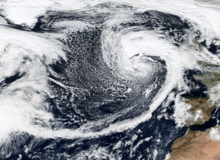 Brian located over the eastern Atlantic on 20 October | |
| Area affected | Ireland, United Kingdom, northern France |
| Date of impact | 21 October 2017[19] |
| Maximum wind gust | 85 mph (137 km/h) Needles, Isle of Wight[35] |
| Lowest pressure | 956 hPa (28.2 inHg)[36] |
| Fatalities | 3 |
| Power outages | Unknown |
| Damage | Unknown |
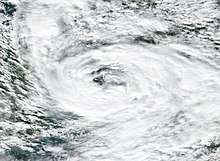
On 13 October, the US National Hurricane Center designated a tropical wave in the Atlantic Ocean to the east of the Lesser Antilles as Invest 92L, giving the system a 40% chance of developing into a tropical cyclone. The NHC continued monitoring the system as it moved slowly north-west, bringing heavy rainfall and flooding to Puerto Rico and the British and US Virgin Islands before turning to the north-east.[37] However, on 16 October, the NHC discontinued monitoring the system as it passed Bermuda without any considerable impact, having failed to transition into a tropical cyclone.
Subsequently, the area of low pressure began to rapidly intensify as it accelerated eastward across the open Atlantic, developing into a powerful extratropical cyclone.[36] On 19 October, Met Éireann issued an orange wind warning for 21 October in counties Galway and Mayo, thus naming storm Brian.[38] On 20 October Met Éireann extended orange warnings to the counties of Clare, Kerry, Waterford and Wexford.[39] The UK Environment Agency warned that storm Brian could combine with high tides and lead to a heightened risk of flooding on the south coast of the UK.[40]
Brian moved over Ireland close to Galway around 07:00 local time on 21 October.[41]
A 67-year-old man drowned after being swept from the sea wall at Dawlish during the storm.[42] Two more people were killed in Ireland from the combined effects of Brian and the prior Hurricane Ophelia.
Cyclone Herwart
| Herwart | |
|---|---|
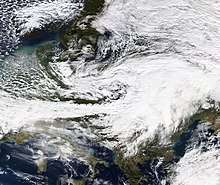 Cyclone Herwart (Ingolf) over Poland on October 29 | |
| Area affected | Denmark, Germany, Poland, Czech Republic, Austria, Slovakia, Hungary |
| Date of impact | 29 October |
| Maximum wind gust | 113 mph (182 km/h), (Luční bouda)[43] |
| Lowest pressure | 970 hPa (29 inHg)[44] |
| Fatalities | 11[45] |
| Power outages | Unknown |
| Damage | Unknown |
Cyclone Herwart was a European windstorm that affected Southern Denmark, Germany, Poland, Austria, Hungary and the Czech Republic on 28–29 October 2017. Named by the Free University of Berlin Meteorology Department, the storm was an extratropical cyclone formed as a secondary low to a more northerly centre of low pressure named Grischa coming southward from the Svalbard Islands region, the latter splitting in two low-pressure areas late on 28 October. The centre of Herwart started rotating counterclockwise around the main low pressure area, passing over Norway, Sweden, Latvia and then losing power while moving over western Russia.
In Denmark, which was hit on 28 October, the storm was named Ingolf. In Hungary, the storm was named Nárcisz (Narcissus), a Hungarian female name whose name day is on 29 October.
Storm Caroline
| Caroline | |
|---|---|
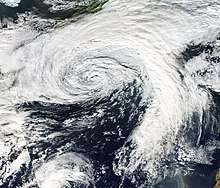 Caroline approaching Britain and Ireland on 5 December | |
| Area affected | Ireland, Scotland, Faroe Islands, Norway |
| Date of impact | 7 December 2017 |
| Maximum wind gust | 93 mph (150 km/h) Fair Isle, Shetland[46] |
| Lowest pressure | 958 hPa (28.3 inHg)[47] |
| Fatalities | 1 |
| Damage | Unknown |
The Met Office named storm Caroline on 5 December to affect Scotland on 7 December, with a yellow warning for wind,[48] which was upgraded on 6 December to an amber warning for the Western Isles, Northern Isles and northern Scotland. Met Éireann issued a yellow warning for wind to the counties of Donegal, Galway, Leitrim, Mayo, Sligo, Clare and Kerry.[49] In its wake, the storm delivered snowy and icy conditions to parts of England and Wales as the winds turned to the north as the system moved into Scandinavia on 8 December, accumulations of 11 cm were recorded on lower ground in Northern Ireland, with a few centimetres of snow in Wales and North-western England. Even with Caroline being located around Scandinavia, Caroline was still impacting the UK weather with a continuation of cold, Arctic air.
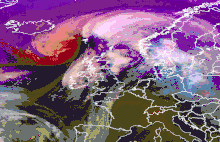
Storm Ana
| Ana | |
|---|---|
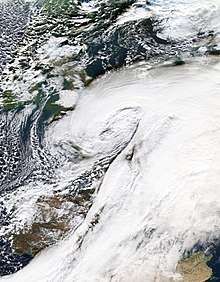 Storm Ana over northwestern France | |
| Area affected | Portugal, Spain, France, Germany, Belgium, Netherlands, Austria, Switzerland, Scandinavia, Russia |
| Date of impact | 10–14 December 2017 |
| Maximum wind gust | 155 mph (249 km/h) |
| Lowest pressure | 957 hPa (28.3 inHg) |
| Fatalities | 1 |
| Power outages | Unknown |
| Damage | Unknown |
Storm Ana was the first storm to ever be officially named by Météo-France, Aemet and IPMA. It formed on 10 December as an area of low pressure that underwent explosive cyclogenesis[Note 1] to the northwest of Iberia passing through the Bay of Biscay into France on the morning of 11 December.[4] It then took a northeasterly direction to affect the Low Countries, Germany, Austria, Scandinavia and eventually Russia.
Her highest gusts reached 249 km/h (155 mph) in the Austrian Alps, and its minimal pressure reached 957 hPa on the morning of 11 December.
Storm Bruno
| Bruno | |
|---|---|
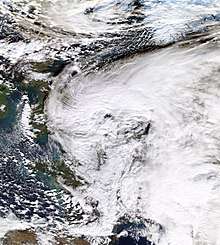 Storm Bruno over the North Sea | |
| Area affected | Portugal,Spain,France |
| Date of impact | 26–28 December 2017 |
| Maximum wind gust | 96 mph (154 km/h) |
| Lowest pressure | 976 hPa (28.8 inHg)[50] |
| Fatalities | 3 |
| Power outages | Unknown |
| Damage | Unknown |
On 26 December 2017, wind warnings were issued in Spain for an area of low pressure that was expected to undergo explosive cyclogenesis. Ultimately, Storm Bruno brought over 25 cm (9.8 in) of snow, wind gusts exceeding 62 mph (100 km/h), and waves as high as 8 m (26 ft) to Spain. One fatality occurred after a man drowned while windsurfing in rough seas. Another fatality occurred after a man was swept off his balcony by high winds and onto his patio, where he immediately succumbed to his injuries.
Storm Dylan
| Dylan | |
|---|---|
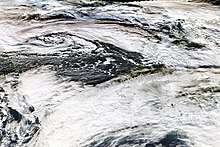 Dylan approaching Britain and Ireland on 30 December 2017 | |
| Area affected | Ireland, Northern Ireland |
| Date of impact | 30–31 December |
| Maximum wind gust | 77 mph (124 km/h)[51] |
| Lowest pressure | 966 hPa (28.5 inHg) |
| Fatalities | Unknown |
| Power outages | ~ 7500 customers in Republic of Ireland affected[52] |
| Damage | Unknown |
Storm Dylan was named by Met Éireann on 29 December. It brought strong winds to the Republic of Ireland, Northern Ireland and southern Scotland overnight 30–31 December. The north and west coasts of the island of Ireland were expected to be affected by gusts of up to 130 km/h.[53][54]
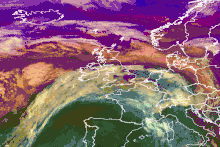
Storm Carmen
| Carmen | |
|---|---|
 Storm Carmen over northern France | |
| Area affected | France, Belgium |
| Date of impact | 31 December 2017 – 2 January 2018 |
| Maximum wind gust | 100 mph (161 km/h), Mount Aigoual[55] (alt 1567m) |
| Lowest pressure | 989 hPa (29.2 inHg)[56] |
| Fatalities | 1 |
| Power outages | 65,000+ [57] |
| Damage | Unknown |
Storm Carmen began as an area of low pressure in late December 2017. The storm went under some intensification before affecting France and other western European countries with strong winds and. A man was killed by Carmen as a tree had fallen on his car during new year celebrations, and a 60-meter (197 feet) tall wind turbine was blown over in the western Vendée region due to extreme winds.[58]
Storm Eleanor/Cyclone Burglind
| Eleanor | |
|---|---|
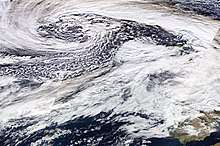 Eleanor approaching Britain and Ireland on 2 January 2018 | |
| Area affected | Ireland, Great Britain, Belgium, France, Germany, Netherlands and Switzerland |
| Date of impact | 2–3 January 2018 |
| Maximum wind gust | 226 km/h (140 mph), Goldau[59] |
| Lowest pressure | 966 hPa (28.5 inHg)[60] |
| Fatalities | 6[61] |
| Power outages | ~150000 customers in Republic of Ireland affected[62] |
| Damage | Unknown |
Named by Met Éireann on 1 January with Amber Wind Warning in force for 2 January. Forecast to bring gusts of 110–130 km/h into the evening. The Met Office also issued a Yellow Wind Warning for 2–3 January, only to upgrade it to an amber warning across Northern England and Southern Scotland 3 hours prior making landfall in the UK.
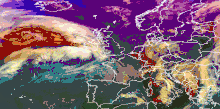
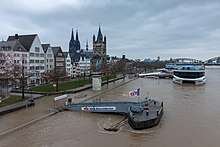
As Eleanor neared Ireland, she brought heavy rainfall and squally weather followed by very strong gusts of 95 mph in Knock Airport in Republic of Ireland.[63] As Eleanor tracked further North-east she continued to strengthen as a sting-jet like feature was evident, however, it did not form. Eleanor also produced thunderstorms and intense hail across England and Wales. The worst damage happened in Northern Ireland.
According to the UK Met Office, gusts reached 90 miles per hour (140 km/h) in Orlock Head, while a mountain weather station in Great Dun Fell recorded 100 miles per hour (160 km/h) gusts.[64]
Storm Cora/Aku
Storm Cora/Aku was the fastest winds in the European windstorm season of 2017–2018. Wind gusts of up to 274 kilometres per hour (170 mph) were reported in some locations, equivalent to a Category 5 hurricane on the Saffir-Simpson Hurricane Scale.
| Cora (NOR), Aku (FIN) | |
|---|---|
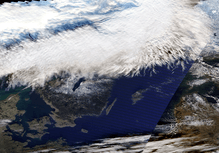 Southern cloud band of Cora over Norway and Sweden on 7 January 2018 | |
| Area affected | Iceland, Scandinavia |
| Date of impact | 7 January 2018 |
| Maximum wind gust | 170 mph (274 km/h)[65] |
| Lowest pressure | 987 hPa (29.1 inHg)[66] |
| Fatalities | Unknown |
| Power outages | Unknown |
| Damage | Unknown |
Storm Fionn
| Fionn | |
|---|---|
 Storm Fionn west of Ireland on 16 January | |
| Area affected | Ireland, Scotland, Iceland, Greenland, United Kingdom, France, Central Europe |
| Date of impact | 14 – 17 January |
| Maximum wind gust | 147 mph (237 km/h) (Botnsheidi, Iceland)[67] |
| Lowest pressure | 935 hPa (27.6 inHg)[68] [Note 1] |
| Fatalities | None |
| Power outages | Unknown |
On 16 January Met Éireann issued orange marine weather warnings for wind to storm force from Roches Point to Slyne Head to Malin Head,[69] along with orange national weather warnings for Donegal, Galway, Leitrim, Mayo, Sligo, Clare, Cork and Kerry for 16—17 January, so naming storm Fionn.[70][71] This system, also called Evi by the FUB, was meteorologically speaking a very deep and large Icelandic low that bottomed out at a central pressure of 935 hPa and dominated the weather in the North Atlantic and Northern Europe for several days in the middle of January 2018. This low had a large and intense wind field on its southern flank, fuelling a strong jetstream that steered the less deep but much more catastrophic Cyclone David into the UK and Ireland and Central Europe on 18 January. After the arrival of David, Fionn weakened and David became the more dominant low, leading to the decay and dissipation of Fionn.
As Fionn neared Ireland, it brought heavy winds to Donegal, Sligo, Mayo, Clare, Leitrim and Cork.
On 16 January the Met Office sent out a clarifying tweet that Fionn was only expected to bring strong winds to western Ireland, with impacts to the UK to be expected to be below their warning thresholds. In the tweet they pointed to a separate weather system to affect the UK on the 17—18 January,[73] later named David by MeteoFrance, this name was reciprocally adopted by the Met Office and Met Eireann. The low David was named Friederike by the Free University of Berlin, with the name Georgina at that time remaining unused.[74]
Met Éireann's decision to name Fionn was met with some criticism from some meteorologists, Liam Dutton tweeted that he thought the warning did not strictly accompany a cyclonic area of low pressure, but a "squeeze of isobars" circulating a low hundreds of kilometres distant in the region of the Faroes, stating that it "needed no more than a standard weather warning".[72] He highlighted the difference in criteria for naming storms employed by the Met Office and Met Éireann (the UK Met Office uses an impact-based criteria, based on the level of expected impacts the weather will bring, whereas the Irish Met Éireann uses fixed numerical criteria, meaning a storm will be named when mean wind speeds are likely to occur, between 65 and 80 km/h and/or gusts between 110 and 130 km/h).[72]
Evelyn Cusack of Met Éireann said that she understood Dutton's point, stating that his criticisms were well made.[75] She reiterated that the orange warning issued by Met Éireann fulfilled their criteria for naming the storm, producing severe winds, coastal flooding and high waves on the Irish coast, even if the centre of circulation was distant.[75]
_2018.png)
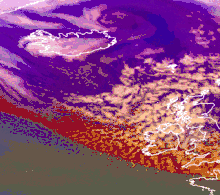
Storm David
| David (FRA), Friederike (GER) | |
|---|---|
 David on 18 January, centred over Benelux or Western Germany | |
| Area affected | Britain, Ireland, France, Benelux, Central Europe, Italy, Eastern Europe |
| Date of impact |
17 – 19 January 2018 (as a storm) (20–22 January as a weak low) |
| Maximum wind gust |
126 mph (203 km/h), Brocken, Saxony-Anhalt[76] (at altitude) |
| Lowest pressure | 974 hPa (28.8 inHg)[76] |
| Fatalities | 13 (2 indirect) +[79][80][81][82] |
| Power outages | 471,000+ [83][84][80][85] |
| Damage |
1 billion [86] – 2.6 billion EUR [87] |
Storm David (also named Friederike),[88] affected an area of Europe from northern France and England, through the Netherlands, Belgium, Germany and the Alps to Poland and the Czech Republic, starting on the evening of 17 January until 19 January.[89] David brought heavy snowfall on its northern flank and high winds (sustained winds up to Bft. 11, widespread hurricane-force gusts) on its southern flank.[90] In some locations, both the high winds and the snowfall occurred, creating blizzard conditions.[91] Amsterdam Airport Schiphol was closed,[92] as well as some airports in Germany. European railroad companies (e.g. the Deutsche Bahn in Germany) could only offer very limited transportation services, if any.[93] Road traffic was similarly disrupted by windthrow, snow, ice, high crosswinds, and by traffic jams that were caused by incidents related to the storm. Widespread damage to manmade structures and to forests occurred.[94] Germany was the worst-hit country as there were 10 known deaths as well as a damage total as high as several hundreds of millions. David/Friederike was the most devastating windstorm in Germany after Cyclone Kyrill in 2007. Coincidentally, Friederike and Kyrill both struck Central Europe on 18 January, albeit 11 years apart.
This storm, which proved to have catastrophic effects, originated from a low pressure trough in the Western Atlantic that stretched from the Southern Caribbean to Newfoundland on 14 January — 16.[95] After gaining a closed circulation near or over Newfoundland on 16 January, the new cyclone entered the very strong southern wind field of the Icelandic Low Fionn, crossing the Atlantic in less than two days and being steered into Europe. Upon the formation of the precursor trough, the GFS and ECMWF correctly predicted that system to impact Europe as a windstorm. Between 14–19 January, the binary storm complex that consisted of Fionn and David brought high winds and snowfall to large portions of Europe. After the storms have passed, they left behind an improved weather situation in Europe that was calmer, drier and warmer.
The storm also brought some hurricane-force gusts and heavy snowfall to Britain and Ireland and caused 140,000 power cuts there. Nevertheless, the storm impacted the Netherlands and Germany in a much more dramatic way. The UK Met Office did not give David a name from its own storm naming list as it did not expect the storm to have a significant impact on Britain, which proved to be an underestimation.
Storm Georgina
| Georgina | |
|---|---|
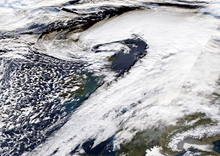 Excellently well-defined low pressure centre of Georgina passing just north of Scotland | |
| Area affected | Ireland, Northern Ireland, Scotland, Norway |
| Date of impact | 23 – 24 January |
| Maximum wind gust | 140 mph (225 km/h),[96] Glencoe Ski area, Scotland |
| Lowest pressure | 959 hPa (28.3 inHg)[97] |
| Fatalities | Unknown |
| Power outages | Numerous |
Storm Georgina was officially named on 23 January after the low pressure area that was nearing Britain and Ireland suddenly had bombed out at 959 hPa. The storm affected the northern parts of Britain, causing numerous power outages as well as flooding and widespread structural damage there.[96] There were widespread gusts in the 50–85 mph range in the affected areas, with an isolated 140 mph gust over a ski area in the Scottish Highlands. Georgina also brought torrential rains to Northern Ireland and Scotland.
After crossing the North Sea, the vigorous low pressure area went on to affect Norway.[98]
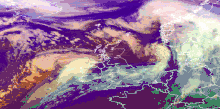
Storm Emma
| Emma (POR), Ulrike (GER) | |
|---|---|
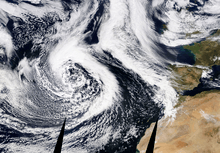 Emma, an extensive cyclone and potential blizzard, on 26 February while being centred near the Azores and threatening Portugal | |
| Area affected | Azores, Madeira, Canary Islands, Morocco, Portugal, Spain, France, Great Britain and Ireland |
| Date of impact | 26 February – 5 March |
| Maximum wind gust | 142 mph (228 km/h), Mont Aigoual, France (alt 1567 m)[99][Note 2] |
| Lowest pressure | 963 hPa (28.4 inHg)[100] |
| Fatalities |
16 |
| Power outages | Unknown |
| Damage | Unknown |
Storm Emma (also named Ulrike) was named while it was centred over the Azores and threatened to strike Western Europe as a blizzard. The cyclone affected Iberia, Great Britain and Ireland on its track, causing high winds and snowfall, leading to blizzard conditions.[102]
As Emma neared southwest England, it brought new cold air to the UK and Ireland, prolonging the cold period.[103] Meteorologists observed the collision of Emma and the Beast from the East and the interaction of the two highly different air masses worsened the wind and snowfall posed by Emma. Starting on 1 March 2018, the collision of Emma and Hartmut triggered numerous hurricane-force gusts in southern Europe and the United Kingdom. The highest of these gusts occurred in the morning of 1 March on Mount Aigoual in southern France at 228 km/h (142 mph).[99]
On 1 March 2018, UK authorities issued a red warning in Wales and south-west England as citizens in Scotland spent up to 20 hours in their cars stuck in traffic in frigid weather and a 46-year-old Southampton man died in a motor vehicle accident on the A34. Schools across the UK were closed in the face of oncoming blizzards, strong winds, and heavy snowfall. Traffic was significantly hindered by the Beast from the East.[104] In Lincolnshire commuters near Boston were stranded by snow and had to freed by farmers with tractors, a minimum of 20 cars and HGVs were snowed in on the A46 close to Faldingworth. The Royal Air Force deployed 4x4 vehicles to transport health and emergency workers.[105] Trains were cancelled across the UK, with over 20 rail operators running at reduced capacity; London's Paddington Station closed for about three hours and 50 stations in Kent closed because of inclement weather. Air travel has been similarly curtailed, as terminals all over the country cancel flights.[104] At least three people died in the UK as a result of the storm.[106]
In Ireland snow began to fall in the east of the country on Tuesday the 27th of February. Snow continued in the east on Wednesday the 28th, with well over 15 cm reported in many areas. Schools closed on Wednesday the 28th in affected areas. Panic buying of food was seen as Storm Emma approached. Storm Emma made landfall on the south coast on Thursday the 1st of March and swept northward. All schools were closed on Thursday the 1st of March and Friday the 2nd nationwide with a red weather warning put in place by Met Eireann. High winds and heavy snowfall on top of the already lying snow led to drifting and severe disruption. Many roads were left impassable, particularly in rural areas and in North Kildare, West Wicklow and Wexford respectively. Power outages and water cuts were reported widely. A Lidl supermarket was torn down and looted in Fortunestown, Tallaght during the chaos caused by the storm. Over 50 cm of lying snow was reported in some locations, with drifts many feet high on many rural routes. Some rural villages were cut off for many days. A slow thaw ensued. Many schools remained closed in Kildare, Wicklow and Wexford on Monday the 5th of March as local authorities continued to attempt to clear roads. [107]
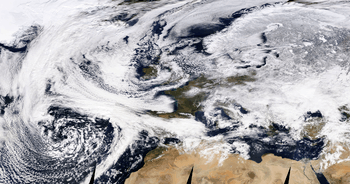
Storm Felix
| Felix | |
|---|---|
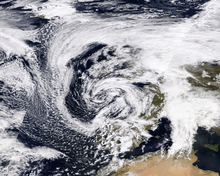 Windstorm Felix in the Bay of Biscay on 11 March 2018 | |
| Area affected |
Azores, Madeira, Canary Islands, Portugal, Spain, France (as a European windstorm) Northeastern United States, Canada (as the precursor nor'easter) |
| Date of impact | 9 March – 11 March |
| Maximum wind gust | 88 mph (141 km/h), Fisterra, Spain (alt 230 m)[109] |
| Lowest pressure | 967 hPa (28.6 inHg)[110] |
| Fatalities | Unknown |
| Power outages | Unknown |
| Damage | Unknown |
Storm Hector
An "off season" windstorm occurring before the 2018 Great Britain and Ireland heat wave.
| Hector | |
|---|---|
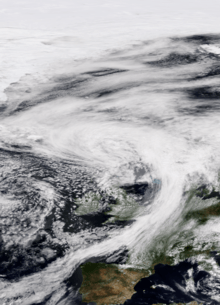 Hector north of the British Isles on 14 June | |
| Area affected | Ireland, United Kingdom and Norway |
| Date of impact | 13 June – 14 June |
| Maximum wind gust | 70 mph (110 km/h), Cairngorms, Scotland [111] |
| Lowest pressure | 971 hPa (28.7 inHg)[112] |
| Fatalities | Unknown |
| Power outages | Unknown |
| Damage | Unknown |
Other systems
"The Beast from the East" cold wave
| Late February 2018 Eurasian cold wave | |
|---|---|
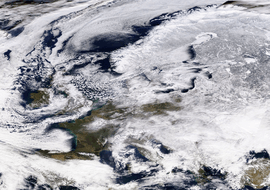 Satellite view showing Europe partially covered in snow under the influence of the strong cold wave on 27 February 2018 | |
| Official names ⦁ FUB/GER |
Hartmut (European part of the system) |
| Nicknames ⦁ UK and Ireland ⦁ France |
Beast from the East Moscow-Paris |
| Area affected | Europe, Siberia, Kazakhstan, Mongolia, Manchuria |
| System type | Anticyclonic complex |
| Disaster type | Cold wave, snowfall event, anticyclonic storm/blizzard |
| Date of impact | 24 February[113] – 10 April |
| Highest pressure | 1056 hPa[114] |
| Maximum wind gust | 187 kilometres per hour (116 mph), Kistefjell, Norway [115] |
| Highest snowfall total | 182 centimetres (72 in), Delnice, Croatia [116](preliminary) |
| Lowest temperature | −40 °C (−40 °F), Kiruna, Sweden[117] (preliminary) |
| Fatalities | 88 |
| Damage | Unknown |
The cold spell, nicknamed the Beast from the East, was caused by a large arctic airmass with anticyclonic structure, stretching from the Russian Far East to Ireland and thus covering large parts of Asia and almost all of Europe.[118] The anticyclone, centred over Scandinavia,[119] was the dominant high pressure area in that weather system and represented its European part. North Asia was covered by other anticyclones that belonged to the same giant arctic airmass. The anticyclone brought cold easterly winds into Continental Europe[120][121][122] and to Ireland and Britain which caused snowfall and sub-zero temperatures due to freezing air from Siberia.[103][123][124][125] In the United Kingdom, the Met Office issued two red snow warnings, meaning a potential risk to life.[126]
This anticyclone, named Hartmut by the commercial Adopt a Vortex program of the Free University of Berlin, was an intense high pressure system that evolved into an anticyclonic storm. A gust of 187 km/h was registered in the Øvre Dividal National Park in Norway, relatively near to the anticyclonic centre.[115] Other hurricane-force gusts delivered by Hartmut were registered across Europe, particularly over Scandinavia, Britain and Ireland. Such hurricane-force anticyclonic storms are relatively rare events compared with cyclonic storms of similar intensity.
At least 87 people died in weather-related deaths during this cold wave. This included 27 in Poland alone, where rough sleeping was becoming a major concern. 16 deaths in the UK were also as a result of ‘The Beast from the East’ cold wave mixing with Storm Emma. The youngest victim was just 7 years old, whereas the oldest was 75.
| "Beast from the East" cold wave fatalities | ||
|---|---|---|
| Country | Fatalities | Notes |
| Poland | 27[127] | |
| UK | 17[106][113][129][130] | Due to mixed effects of Storm Emma and the cold wave.[101][131] |
| Slovakia | 7[113][132] | |
| France | 7[127][128][113][120][120][133] | |
| Czech Republic | 6[122] | |
| Romania | 6[118][134][127][132][128][118][118][120][118][120][120] | |
| Lithuania | 5[128] | |
| Spain | 3[128] | |
| Serbia | 3[132][122][128][135] | |
| Slovenia | 3[132][122][128][135] | |
| Italy | 3[128] | |
| Sweden | 1[136][115] | |
| The Netherlands | 1[128] | |
| Germany | 1[128] | |
| Denmark | 1[122][128] | |
| Bosnia-Hersigovina | 1[132][135][137] | |
| Croatia | 1[132][135] | |
| Albania | 1[132][133][138] [133] | |
| Bulgaria | 1[132] | |
| Total | 93 | |
Season effects
This table lists all known windstorms that affected the UK and Ireland during 2017–2018. It includes their name, duration, peak recorded gust (excluding mountain stations), lowest pressure, areas affected, deaths and damage totals from the two nations.
| Storm | Dates active | Highest wind gust | Lowest pressure | Casualties | Damages | Affected areas |
|---|---|---|---|---|---|---|
| Aileen | 12 – 13 September | 100 mph / 161 km/h[8] | 978 hPa | 3 | Unknown | Ireland, United Kingdom, Netherlands, Germany |
| Xavier | 4 – 6 October | 126 mph / 202 km/h | 985 hPa | 9 | €325 million[139] | Germany, Poland, Czech Republic |
| Ophelia | 15 – 18 October | 96.7 mph / 155.6 km/h[20] |
960 hPa (tropical) |
5 | €60 million[24] | Azores, Portugal, Spain, France, Ireland, United Kingdom, Faroe Islands, Norway, Sweden, Finland, Estonia, Russia |
| Brian | 20 – 22 October | 85 mph / 137 km/h[35] | 956 hPa | 3 | Unknown | Ireland, United Kingdom, northern France |
| Herwart | 29 October | 113 mph / 182 km/h | 970 hPa | 11 | €255 million[140] | Denmark, Germany, Poland, Czech Republic, Austria, Slovakia, Hungary |
| Caroline | 6 – 10 December | 93 mph / 150 km/h[141] | 958 hPa | 1 | Unknown | Ireland, Scotland, Faroe Islands, Norway |
| Ana | 10 – 14 December | 155 mph / 249 km/h | 957 hPa | 1 | Unknown | Portugal, Spain, France, Germany, Belgium, Netherlands, Austria, Switzerland, Scandinavia, Russia |
| Bruno | 26 – 28 December | 96 mph / 154 km/h | 976 hPa | 3 | Unknown | Portugal,Spain,France |
| Dylan | 30 – 31 December | 77 mph / 124.1 km/h[142] | 966 hPa [143] | 0 | Unknown | Ireland, Northern Ireland |
| Carmen | 31 December – 2 January | 100 mph / 161 km/h | 989 hPa | 1 | Unknown | France, Belgium |
| Eleanor | 2 – 3 January | 140 mph / 226 km/h[144] | 966 hPa | 6 | €643 million [61] | Ireland, Great Britain, Belgium, France, Germany, Netherlands, Switzerland |
| Cora/Aku | 7 January | 170 mph / 274 km/h | 987 hPa | 0 | Unknown | Iceland, Norway, Sweden |
| Fionn | 16 January | 147 mph/ 237 km/h | 935 hPa[68] [Note 1] | 0 | Unknown | Ireland, Scotland, Iceland, Greenland, United Kingdom, France, Central Europe |
| David | 17 – 19 January | 126 mph / 203 km/h | 974 hPa[76] | 15 | €1.465 billion[145] | United Kingdom, Ireland, France, Netherlands, Belgium, Luxembourg, Germany, Austria, Switzerland, Italy, Poland, Czech Republic, Slovakia, Hungary, Belarus, Ukraine, Russia |
| Georgina | 23 – 24 January | 140 mph / 225 km/h | 959 hPa | 0 | Unknown | Ireland, Northern Ireland, Scotland, Norway |
| Emma | 26 February – 3 March | 142 mph / 228 km/h | 963 hPa | 16 | Unknown | Azores, Madeira, Canary Islands, Morocco, Portugal, Spain, France, Great Britain and Ireland |
| Felix | 9 – 11 March | 88 mph / 141 km/h | 967 hPa | 0 | Unknown | Azores, Madeira, Canary Islands, Portugal, Spain, France |
| Hector | 13 – 14 June | 100 mph / 161 km/h | 971 hPa | 0 | Unknown | Ireland and Great Britain |
| 18 windstorms | 12 September – 14 June | 170 mph / 274 km/h | 935 hPa | 74 | €2.748 billion+ |
Storms named by European meteorological services
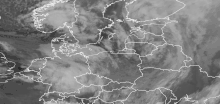

2017–18 named storms
- Aileen (UK/IE), Sebastian (Free University of Berlin), 12–13 September.
- Xavier (Free University of Berlin), 4–6 October.
- Ex-Hurricane Ophelia (NWS), 16–17 October.
- Brian (UK/IE), Elmar (Free University of Berlin), 21 October.
- Herwart (FUB),[146] Ingolf (dk)[147] Grzegorz (Polish derivative of the FUB name)[148], 28–29 October.
- Ylva (No),[149] Reinhard (FUB),[150] 22–23 November.
- Caroline (UK/IE), Walter (FUB), Aina (No),[151] 7–8 December 2017.
- Ana (Fr/Es/Pt),[3] Yves (FUB), 10–11 December.
- Birk (No-for heavy rainfall),[152] Diethelm (FUB), 23 December 2017.
- Bruno (Fr/Es/Pt), Edilbert (FUB), 26–27 December 2017.[153]
- Dylan (UK/IE), Horst (FUB), 29–31 December 2017.[154]
- Carmen (Fr/Es/Pt), Ingmar (FUB), 1 January 2018.[155]
- Eleanor (UK/IE), Burglind (FUB), 2–3 January 2018.[156]
- Aku (Fin),[157] Cora (No),[158] Unnamed (FUB) -later absorbed by Christine, 7 January 2018.
- Fionn (UK/IE), Evi (FUB), 16 January 2018.
- David (Fr/Es/Pt),[159] Friederike (FUB),[160] 18 January 2018.
- Georgina (UK/IE),[161] Helene (FUB), 23–24 January 2018.
- Emma (Fr/Es/Pt), Ulrike (FUB), 26 February-5 March 2018
- Felix (Fr/Es/Pt),[162] Yuliya (FUB), 10–11 March 2018
- Gisele (Fr/Es/Pt),[163] Zsuzsa (FUB), 14 March 2018.
- Hugo (Fr/Es/Pt)[164] Carola (FUB) 24–25 March 2018.
- Irene (Fr/Es/Pt) 30 March–10 April 2018.
See also
Notes
- ^ Lowest pressure for the cyclonic centre of Fionn was achieved on 14 January to the north of Iceland, at the time of Fionn's naming on the 16 January the cyclonic centre had substantially filled to about 961 hPa.[165]
- ^ The 142 mph gust occurred in the squeezed isobar region between the centres of Emma and Hartmut, thus it was probably caused by the mixed effects of the two systems due to their collision.[166]
References
- ↑ "Storm names for 2017–18 announced". BBC Weather. British Broadcasting Corporation. 6 September 2017. Retrieved 6 September 2017.
- ↑ "Storm names for 2017–18 announced". Met Office. 6 September 2017. Retrieved 6 September 2017.
- 1 2 France, Meteo (4 December 2017). "Météo-France nomme les tempêtes". www.meteofrance.fr (in French). Retrieved 9 December 2017.
- 1 2 Meteorología, Agencia Estatal de (7 December 2017). "Aemet, MéteoFrance y el IMPA, pondrán nombre a las borrascas profundas que puedan afectar a España, Francia o Portugal. – Agencia Estatal de Meteorología – AEMET. Gobierno de España". www.aemet.es (in Spanish). Retrieved 9 December 2017.
- ↑ "Météo-France, junto con AEMET e IPMA, nombra a las borrascas intensas con fuertes vientos – Revista del Aficionado a la Meteorología". Revista del Aficionado a la Meteorología (in Spanish). 4 December 2017. Retrieved 9 December 2017.
- ↑ "Ana, la primera borrasca con nombre en España". abc (in Spanish). 8 December 2017. Retrieved 9 December 2017.
- ↑ Duemmel, Sebastian Boelling, Thomas; otto@bibo.met.fu-berlin.de, sebastian.boelling@rz.hu-berlin.de,; Informationssysteme, Freie Universitaet Berlin – Meteorologisches Institut – Meteorologische Kommunikations- und; www@www.met.fu-berlin.de (1 January 2000). "Homepage – und Kommunikationssysteme der Freien Universitaet Berlin". www.met.fu-berlin.de.
- 1 2 "Messwerte vom 13.09.2017, 12:00 Uhr – Niederlande".
- ↑ "Analysis chart". wetter3.de.
- ↑ "Drei Tote wegen Unwetters – Rollstuhlfahrer in Fluss geweht". welt.de. 13 September 2017. Retrieved 13 March 2017.
- ↑ "Storm Aileen to bring strong winds to south of country". 12 September 2017.
- 1 2 "Storm Aileen first named storm of Autumn 2017". Met Office. 12 September 2017. Retrieved 12 September 2017.
- 1 2 3 4 "Storm Aileen leaves thousands without power". The Times. 13 September 2017. Retrieved 13 September 2017.
- ↑ "Storm Aileen: 60,000 homes lost power during 75 mph winds". BBC News. 13 September 2017. Retrieved 13 September 2017.
- ↑ Root, Jordan (12 September 2017). "Aileen's damaging winds to sweep across UK while Germany braces for Sebastian". AccuWeather. Retrieved 12 September 2017.
- ↑ "Bilanz von 'Xavier': Böen bis 202 Kilometer pro Stunde". Meteo (in German). Schweizer Radio und Fernsehen. 6 October 2017. Retrieved 7 October 2017.
- ↑ "Sturmtief XAVIER – der Tag danach" (in German). German Weather Service. 6 October 2017. Retrieved 7 October 2017.
- ↑ "Global Catastrophe Recap October 2017" (PDF). Aon. Retrieved 4 January 2018.
- 1 2 "UK Storm Centre – Met Office Barometer". www.metoffice.gov.uk. Retrieved 19 November 2017.
- 1 2 "Annual Summary 2017" (PDF). Met Éireann. 3 January 2018. Retrieved 4 January 2018.
- ↑ @MetEireann (16 October 2017). "The eye of the storm passed over Valentia Observatory in Co. Kerry. Graphic of MSLP (pressure) below. Central pressure was 959 hPa" (Tweet) – via Twitter.
- ↑ @MetEireann (17 October 2017). "Storm Ophelia on Monday 16 October 2017. Provisional Quick Facts" (Tweet) – via Twitter.
- ↑ "Analysis Chart". wetter3.de.
- 1 2 "EUR 49M IRELAND, GBP 10M UK – INSURED MARKET LOSS FOR EX-HURRICANE OPHELIA" (PDF). Perils.org. 27 November 2017. Retrieved 28 November 2017.
- ↑ Office, Met. "Weather warnings". www.metoffice.gov.uk.
- ↑ "Update on Ophelia – Weather News – Met Éireann – The Irish Meteorological Service Online". Met Éireann. 13 October 2017. Retrieved 13 October 2017.
- ↑ Met Éireann [@MetEireann] (14 October 2017). "RED WIND WARNING ISSUED For Cork, Kerry, Clare, Galway & Mayo Valid: Mon 9am – Tues 3am Gusts in excess of 130 km/h" (Tweet) – via Twitter.
- ↑ Farrow, Jo (15 October 2017). "Ireland and Ophelia, winds, waves and disruption". netweather.tv. Retrieved 15 October 2017.
- ↑ "Weather Warnings – Met Éireann – The Irish Meteorological Service Online". Met Éireann. 14 October 2017. Retrieved 14 October 2017.
- ↑ "Status red wind warning extended across the country". RTE.ie. 15 October 2017. Retrieved 15 October 2017.
- ↑ Met Office [@metoffice] (15 October 2017). "A yellow weather warning for #wind has been updated: bit.ly/WxWarning Stay #weatheraware @metofficeuk" (Tweet) – via Twitter.
- ↑ Farrow, Jo (17 October 2017). "What a storm. Bizarre hurricane, dangerous gusts & waves and that sky! Ophelia – Blog by Jo Farrow". Netweather.tv. Retrieved 17 October 2017.
- ↑ "Hurricane Ophelia: Woman killed as tree hits car". BBC News. 16 October 2017.
- 1 2 "Hurricane Ophelia: Three people die as storm hits Ireland". BBC News. 16 October 2017. Retrieved 16 October 2017.
- 1 2 "Storm Brian – Met Office Barometer". www.metoffice.gov.uk. Retrieved 4 January 2018.
- 1 2 Finnis, Nick (20 October 2017). "Storm Brian – Key Messages On UK & Ireland Impacts". Netweather.tv. Retrieved 20 October 2017.
- ↑ "Invest 92L Could Develop Into a Tropical Depression or Tropical Storm Early This Week While Tracking Toward Bermuda". The Weather Channel.
- ↑ "Weather Warnings – Met Éireann – The Irish Meteorological Service Online". Met Éireann. 19 October 2017. Retrieved 19 October 2017.
- ↑ "Weather Warnings – Met Éireann – The Irish Meteorological Service Online". Met Éireann. 20 October 2017. Retrieved 20 October 2017.
- ↑ "Storm Brian to arrive this weekend". Met Office. 19 October 2017. Retrieved 19 October 2017.
- ↑ "UK rainfall radar data for 21 October 2017". The Weather Outlook. 21 October 2017. Retrieved 22 October 2017.
- ↑ Henderson, Guy (26 October 2017). "Body found on beach: Man's last words were phone call about size of Storm Brian waves". Devonlive. Retrieved 27 October 2017.
The 67-year-old Paignton man spoke on the phone about the size of the waves hitting the sea wall at Dawlish and drowned moments later, an inquest has heard
- ↑ "Extrémně silná bouře má třetí oběť. Tisíce lidí jsou stále bez elektřiny" (in Czech). Mladá fronta Dnes. Retrieved 2017-11-01.
- ↑ "Tlaková níž Herwart priniesla nielen víchricu, ale aj zimné búrky – MeteoInfo.sk". meteoinfo.sk (in Slovak). 30 October 2017. Retrieved 12 December 2017.
- ↑ "Extratropical cyclone Herwart loss put at EUR 252m by PERILS | Artemis.bm". Artemis.bm – The Catastrophe Bond, Insurance Linked Securities & Investment, Reinsurance Capital, Alternative Risk Transfer and Weather Risk Management Blog. 11 December 2017. Retrieved 11 December 2017.
- ↑ @metoffice (7 December 2017). "Here are some of the strongest gusts from #StormCaroline today. Friday will be another blustery day but the winds should be a little lighter for most #weatheraware" (Tweet) – via Twitter.
- ↑ "Chart". wetter3.de.
- ↑ "Storm Caroline bringing gales to Scotland". Met Office. 5 December 2014. Retrieved 5 December 2017.
- ↑ "Weather Warnings – Met Éireann – The Irish Meteorological Service Online". Met Éireann. 5 December 2017. Retrieved 5 December 2017.
- ↑ "Analysis chart". wetter3.de.
- ↑ "Storm Dylan – Met Office Barometer". www.metoffice.gov.uk. Retrieved 3 January 2018.
- ↑ "Storm Dylan passes with minimal disruption to electricity supply". www.esbnetworks.ie. Archived from the original on 3 January 2018. Retrieved 2 January 2018.
- ↑ "Wet and windy end to 2017". Met Office. Retrieved 29 December 2017.
- ↑ Éireann, Met. "Met Éireann – The Irish Weather Service". www.met.ie. Retrieved 30 December 2017.
- ↑ "Messwerte vom 01.01.2018, 19:00 Uhr – Languedoc-Roussillon".
- ↑ "Analysis chart". wetter3.de.
- ↑ "About 65,000 French homes without power due to winter storm". France 24. 1 January 2018. Retrieved 27 February 2018.
- ↑ France, Meteo (2 January 2018). "Storm Eleanor heads for France after Carmen chaos". Retrieved 27 February 2018.
- ↑ "Messwerte vom 03.01.2018, 12:00 Uhr – Zug".
- ↑ Holland, Peter (17 January 2018). "Eleanor/Burglind: Another "Near-miss" for Europe? | The RMS Blog". www.rms.com. Retrieved 17 January 2018.
- 1 2 "Perils Puts Initial Loss Estimate for Extratropical Cyclone Burglind (Eleanor) at EUR 643M" (PDF). Perils.org. 13 February 2018. Retrieved 14 February 2018.
- ↑ "Crews continue to restore power to customers affected by Storm Eleanor". www.esbnetworks.ie. Archived from the original on 4 January 2018. Retrieved 3 January 2018.
- ↑ Éireann, Met. "Update on storm Eleanor: Highest gust recorded at Knock Airport at 84 kts at 7pm this evening".
- ↑ Office, Met. "It's been a wild and stormy night for some us, all courtesy of the passage of #StormEleanor. Still very windy out there so take care if you're heading out. *Great Dun Fell is a mountain weather stationpic.twitter.com/I1jHoFmhHq".
- ↑ "Messwerte vom 07.01.2018, 09:00 Uhr – Sogn og Fjordane".
- ↑ "Analysis chart". wetter3.de.
- ↑ "Messwerte vom 14.01.2018, 05:00 Uhr – Höfuðborgarsvæði".
- 1 2 "1800 UTC 14 Jan 2018 Analysis chart". Met Office. Retrieved 20 January 2018.
- ↑ "Weather Warnings – Met Éireann – The Irish Meteorological Service Online". Met Éireann. 16 January 2018. Retrieved 16 January 2018.
- ↑ @MetEireann (16 January 2018). "Status orange warning for wind For Donegal, Galway, Leitrim, Mayo, Sligo, Clare, Cork and Kerry-Storm Fionn" (Tweet) – via Twitter.
- ↑ "Weather Warnings – Met Éireann – The Irish Meteorological Service Online". Met Éireann. 16 January 2018. Retrieved 16 January 2018.
- 1 2 3 Dutton, Liam (18 January 2018). "Why I criticised Met Eireann for naming Storm Fionn". Channel 4 News. Retrieved 24 January 2018.
- ↑ @metoffice (16 January 2018). "The 6th named storm of the season has been named by @MetEireann #StormFionn will bring strong winds to western Ireland tonight, but impacts are currently expected to be below warning limits in the UK. A separate weather system will bring more windy weather to the UK Weds night" (Tweet) – via Twitter.
- ↑ Noble, Jason. "Fionn, Georgina, Friederike, David – what is the name of the storm? Find out here". East Anglian Daily Times. Retrieved 24 January 2018.
- 1 2 "Here's what Evelyn Cusack has to say about Channel 4 weather presenter's criticism of Storm Fionn naming – Independent.ie". Independent.ie. 18 January 2018. Retrieved 25 January 2018.
- 1 2 3 Wetterdienst, Deutscher. "Orkantief FRIEDERIKE wütet am 18. Januar 2018 über Europa" (PDF) (in German). Retrieved 29 January 2018.
- ↑ "BRITAIN IS BATTERED BY 95 MPH WINDS". Swazi Observer. 19 January 2018. Retrieved 19 January 2018.
- ↑ Office, Met. "Capel Curig climate". www.metoffice.gov.uk. Retrieved 28 January 2018.
- ↑ "Wetterdienst: "Das ist ein Extremorkan"". Mitteldeutscher Rundfunk. 18 January 2018. Retrieved 18 January 2018.
- 1 2 "Orkantief "Friederike" – "Die Bäume fallen um wie Streichhölzer"". SPIEGEL ONLINE. 18 January 2018. Retrieved 18 January 2018.
- ↑ "Storm Friederike kills at least seven across western Europe with winds of 200 kph". Euronews. 18 January 2018. Retrieved 19 January 2018.
- ↑ "Die Bahn fährt wieder – teilweise". ZDF. 19 January 2018. Retrieved 19 January 2018.
- ↑ "Thousands lose power after gales hit UK". BBC News. 18 January 2018. Retrieved 18 January 2018.
- ↑ "Liveblog: Orkan "Friederike" fordert zwei Todesopfer – Fernverkehr bundesweit eingestellt". wz.de. 18 January 2018. Retrieved 18 January 2018.
- ↑ "Storm David sweeps northern Europe". TECH2. 19 January 2018. Retrieved 26 January 2018.
- ↑ ""Friederike" kostet rund eine Milliarde Euro". Tagesschau (ARD). 25 January 2018. Retrieved 25 January 2018.
- ↑ Insurance, Business. "Storm Friederike insured losses as high as $3.22B: AIR Worldwide". Retrieved 29 January 2018.
- ↑ "Tempête David sur le Nord". www.meteofrance.fr (in French). 18 January 2018. Retrieved 19 January 2018.
- ↑ "Mehrere Tote durch Sturmtief "Friederike" in Europa". Salzburger Nachrichten. 18 January 2018. Retrieved 19 January 2018.
- ↑ "Orkan: Tote und Bahn-Chaos". ZDF. 18 January 2018. Retrieved 19 January 2018.
- ↑ "Met Office criticised for not naming storm which battered Britain as fresh weather warnings are issued". The Telegraph. 18 January 2018. Retrieved 19 January 2018.
- ↑ "Sturm "Friederike" verursacht Verkehrschaos in den Niederlanden". Wochenblatt. 18 January 2018. Retrieved 19 January 2018.
- ↑ "Sechs Todesopfer, 140.000 Haushalte ohne Strom". welt.de. 18 January 2018. Retrieved 19 January 2018.
- ↑ "Sturm "Friederike" kostet Versicherer etwa 500 Millionen Euro". SPIEGEL ONLINE. 18 January 2018. Retrieved 19 January 2018.
- ↑ http://www.wpc.ncep.noaa.gov/archives/sfc/2018/satsfcnps2018011415.gif, retrieved on 23 January 2018
- 1 2 "Storm Georgina hits Scotland with heavy rain, gusts up to 225 km/h (140 mph)". The Watchers. 25 January 2018. Retrieved 25 January 2018.
- ↑ "0600 UTC 24 Jan 2018 UKMET Analysis chart". Retrieved 20 January 2018.
- ↑ "1800 UTC 24 Jan 2018 UKMET Analysis chart". Retrieved 20 January 2018.
- 1 2 "Messwerte vom 01.03.2018, 7:00 Uhr – Languedoc-Roussillon".
- ↑ "Analysis chart". wetter3.de.
- 1 2 3 Sales, Dan (2018-03-03). "UK weather sparks warnings to 'evacuate now' despite dangerous roads as Storm Emma brings deadly flooding and freezing rain". the Guardian. Retrieved 2018-03-03.
- ↑ "Seven counties in Ireland on snow alert as Storm Emma approaches". The Irish Post. 26 February 2018. Retrieved 27 February 2018.
- 1 2 Greenfield, Patrick (2018-02-26). "UK braces for 'beast from the east' as Met Office warns of snow". the Guardian. Retrieved 2018-02-27.
- 1 2 "Storm Emma: Red warning in Wales and south-west England". BBC News. BBC. 1 March 2018. Retrieved 2 March 2018.
- ↑ "Motorists stuck as snow blocks major roads in Lincolnshire". BBC News. BBC. 1 March 2018. Retrieved 1 March 2018.
- 1 2 Duggan, Joe (2 March 2018). "Forty cars involved in huge pile-up as Brits battle home in treacherous weather".
- ↑ "Storm Emma: At a glance". 4 March 2018.
- ↑ "Worldview: Explore Your Dynamic Planet". worldview.earthdata.nasa.gov.
- ↑ "Messwerte vom 09.03.2018, 23:00 Uhr – Galicien" (in German).
- ↑ "Analysis chart". wetter3.de.
- ↑ "Strong Winds from Storm Hector".
- ↑ https://www.metoffice.gov.uk/climate/uk/interesting/june2018_wind
- 1 2 3 4 5 6 "AFP.com". AFP.com.
- ↑ "Analysis chart". wetter3.de.
- 1 2 3 "Messwerte vom 28.02.2018, 07:00 Uhr – Troms". Retrieved 2 March 2018.
- ↑ "'Beast from the East' kills two in Romania as freeze hits Europe". abc News. 2018-02-28. Retrieved 2018-03-03.
...Snowfall of 182 centimetres recorded in Delnice, Croatia...
- ↑ "Record-setting cold weather continues to grip Europe". Anadolu Agency. 2018-03-01. Retrieved 2018-03-02.
...while the snow depth has reached 172 centimeters (5.64 feet) in the town of Delnice...The coldest place in Europe was reportedly in the town of Kiruna, Sweden at minus 40 degrees Celsius (minus 40 degrees Fahrenheit)...
- 1 2 3 4 5 "Two killed as 'Beast from the East' paralyses Europe". 28 February 2018.
- ↑ "Analysis chart". met.fu-berlin.de.
- 1 2 3 4 5 6 7 8 "Deadly storm dubbed 'Beast from the East' pounds Europe". 27 February 2018.
- ↑ "The Latest: Brussels homeless forced inside amid cold snap".
- 1 2 3 4 5 "The Latest: Cold weather kills mean in Slovenia, Serbia". 28 February 2018.
- ↑ Greenfield, Patrick; Rawlinson, Kevin (2018-02-23). "Siberian blast could make southern England colder than the Arctic". the Guardian. Retrieved 2018-02-28.
...Freezing air from Siberia...
- ↑ Thorne, Peter (2018-02-26). "Q&A: What is causing these severe snow warnings?". the Irish Times. Retrieved 2018-02-28.
There have been many worse winters in the past, but not in the last 30 years. Met Éireann have a good compendium of historical events available at www.met.ie. ... Peter Thorne is Professor in Physical Geography (Climate Change) at NUI Maynooth and Director of the Irish Climate Analysis and Research Unit group (Icarus)
- ↑ LeCouer, Jack (2018-02-26). "Be Ready As Beast Set To Bite". Nova.ie. Retrieved 2018-02-28.
Evelyn Cusack from Met Éireann says the winds coming from Siberia will mean it’s exceptionally cold, and said it’s been more than 30 years since we’ve seen this kind of weather: “I’m not saying that it’s going to be as bad, maybe it’ll be worst.”
- ↑ "UK weather: Snow causing widespread travel disruption". BBC News. BBC. 28 February 2018. Retrieved 28 February 2018.
- 1 2 3 "Deadly storm dubbed 'Beast from the East' pounds Europe". 27 February 2018.
- 1 2 3 4 5 6 7 8 9 10 11 "{title}". Archived from the original on 3 March 2018. Retrieved 2 March 2018.
- ↑ News, ABC. "ABC News". ABC News.
- ↑ "Ice-Proofing Pays Off as Heathrow Endures Rare London Blizzard". 1 March 2018 – via www.bloomberg.com.
- 1 2 3 "Body found in canal in search for Manchester teen who vanished in cold weather". 3 March 2018.
- 1 2 3 4 5 6 7 8
- 1 2 3 http://amp.miamiherald.com/news/nation-world/article202314409.html
- ↑ "'Beast from the East' causes death, disruption in Europe".
- 1 2 3 4 "Deadly storm dubbed 'Beast from the East' pounds Europe – Today World News Online". todayworldnewsonline.com.
- ↑ "Record-setting cold weather continues to grip Europe". Anadolu Agency.
- ↑ "Deadly storm dubbed 'Beast from the East' pounds Europe – Today World News Online". todayworldnewsonline.com.
- ↑ http://amp.miamiherald.com/news/business/article202123994.html
- ↑ "PERILS discloses second loss estimate for extratropical cyclone Xavier of EUR 325m". Perils.org. 5 January 2018. Retrieved 12 March 2018.
- ↑ "PERILS discloses second loss estimate for extratropical cyclone Herwart of EUR 255m". Perils.org. 29 January 2018. Retrieved 12 March 2018.
- ↑ "Storm Caroline – Met Office Barometer". www.metoffice.gov.uk. Retrieved 4 January 2018.
- ↑ "Weather Summary for December 2017". www.met.ie. Met Éireann. 3 January 2018. Retrieved 4 January 2018.
- ↑ "Analysis chart". wetter3.de.
- ↑ "Storm Eleanor – Met Office Barometer". www.metoffice.gov.uk. Retrieved 4 January 2018.
- ↑ "PERILS discloses first loss estimate for extratropical cyclone Friederike (David) of EUR 1,465m". Perils.org. 28 February 2018. Retrieved 12 March 2018.
- ↑ "Wetter und Klima – Deutscher Wetterdienst – Thema des Tages – Archiv – "HERWART" – ein weiterer Herbststurm steht vor der Tür". www.dwd.de (in German). 28 October 2017. Retrieved 28 October 2017.
- ↑ "Følg et blæsevejr med dmi.dk: DMI". www.dmi.dk (in Danish). 28 October 2017. Retrieved 28 October 2017.
- ↑ "Nad Polskę nadciąga orkan Grzegorz. IMGW wydało ostrzeżenia". WPROST.pl (in Polish). 27 October 2017. Retrieved 28 October 2017.
- ↑ Svendsen, Roy Hilmar; Rommetveit, Astrid (22 November 2017). "Ekstremværet "Ylva" treffer Nord-Norge". NRK (in Norwegian). Retrieved 23 November 2017.
- ↑ "Thema des Tages – Archiv – Reinhard oder Ylva – Wie Tiefs zu ihren Namen kommen". www.dwd.de (in German). 24 November 2017. Retrieved 29 November 2017.
- ↑ "Nå kommer "Aina": – Vi frykter store ødeleggelser". Bergens Tidende (in Norwegian Bokmål). 7 December 2017. Retrieved 7 December 2017.
- ↑ "Ekstremværet "Birk"". NRK (in Norwegian Bokmål). Retrieved 23 December 2017.
- ↑ "Manche. Un coup de vent et une tempête à douze heures d'intervalle". Ouest-France.fr (in French). Retrieved 27 December 2017.
- ↑ "Weather Warnings – Met Éireann – The Irish Meteorological Service Online". 29 December 2017. Retrieved 29 December 2017.
- ↑ "Une nouvelle tempête, "Carmen", pourrait frapper la France pendant le Nouvel an". FIGARO (in French). 29 December 2017. Retrieved 29 December 2017.
- ↑ (www.dw.com), Deutsche Welle. "Storm Eleanor — also known as Burglind — batters Europe". DW.COM. Retrieved 3 January 2018.
- ↑ "Aku-myrskyn tuulet ovat nousseet jo myrskylukemiin – Myrsky pätkii sähköjä länsirannikolla". Yle Uutiset (in Finnish). 7 January 2018. Retrieved 7 January 2018.
- ↑ "Ekstremværet "Cora" treffer Midt-Norge søndag – kan bli orkan på kysten". NRK (in Norwegian Bokmål). 7 January 2018. Retrieved 7 January 2018.
- ↑ @meteofrance (17 January 2018). "La #tempêteDavid d'intensité moyenne va traverser le Nord-Pas-de-Calais demain jeudi en tout début de journée. Rafales prévues jusqu'à 120 km/h sur les côtes, 100/110 km/h dans les terres. Restez prudents" (Tweet) – via Twitter.
- ↑ "Alerte vent: des rafales proches des 100 km/h cette nuit et ce jeudi matin". RTBF Info (in French). 17 January 2018. Retrieved 17 January 2018.
- ↑ @MetEireann (23 January 2018). "Storm Georgina Status Orange Warning for Ireland" (Tweet) – via Twitter.
- ↑ "AVISO ESPECIAL DE FENÓMENOS ADVERSOS AVISO ESPECIAL NÚMERO 18/2018" (PDF) (in Spanish). AEMET. 8 March 2018. Retrieved 8 March 2018.
- ↑ "Instituto Português do Mar e da Atmosfera" (in Portuguese). IPMA. 14 March 2018. Retrieved 14 March 2018.
- ↑ "PREDICCIÓN ESPECIAL DE LA AGENCIA ESTATAL DE METEOROLOGÍA PARA LA SEMANA SANTA (Elaborada el 22-3-2018)" (PDF) (in Spanish). AEMET. 22 March 2018. Retrieved 22 March 2018.
- ↑ "Met Office Chart 18 UTC 16 January 2018". Met Office. Retrieved 25 January 2018.
- ↑ "Met Office Chart 06 UTC 01 March 2018". Met Office. Retrieved 3 March 2018.
